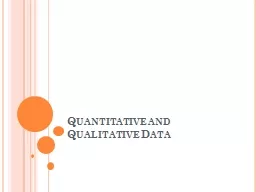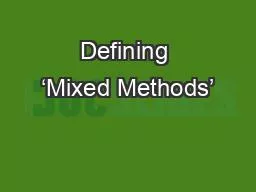PPT-Quantitative and Qualitative Data
Author : stingraycartier | Published Date : 2020-06-16
Quantitative or Qualitative Johns reaction time with 10 hours sleep averaged021 seconds with 6 hours sleep it was 028 seconds Jenny gave a detailed account of her
Presentation Embed Code
Download Presentation
Download Presentation The PPT/PDF document "Quantitative and Qualitative Data" is the property of its rightful owner. Permission is granted to download and print the materials on this website for personal, non-commercial use only, and to display it on your personal computer provided you do not modify the materials and that you retain all copyright notices contained in the materials. By downloading content from our website, you accept the terms of this agreement.
Quantitative and Qualitative Data: Transcript
Download Rules Of Document
"Quantitative and Qualitative Data"The content belongs to its owner. You may download and print it for personal use, without modification, and keep all copyright notices. By downloading, you agree to these terms.
Related Documents














